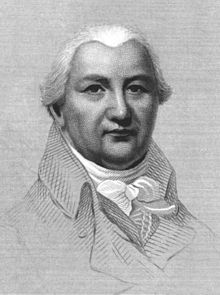Charles Hutton
Charles Hutton (born August 14, 1737 in Newcastle-upon-Tyne , † January 27, 1823 in London ) was an English mathematician . During his lifetime he was known as the author of school and textbooks in England.
Hutton was the son of a mine overseer. A childhood accident that left his elbow disabled prevented him from pursuing the same career. He became a teacher, attended evening classes in mathematics in Newcastle, and in 1760 he himself opened a school for mathematics lessons and gave private lessons. Among his students was the future Lord Chancellor John Scott. He published his first arithmetic textbook ( The Schoolmasters Guide- or a complete system of practical arithmetic ) in 1764 and also began to train teachers. A Treatise on mensuration followed in 1767 . At the same time he worked for the city of Newcastle as a surveyor (map of Newcastle and the surrounding area 1770) and published a book on bridge construction in 1772. In 1773 he won the competition for the position of mathematics teacher at the Royal Military Academy in Woolwich. A property speculation as part of the relocation of the Royal Academy made him wealthy in the mid-1780s. In 1807 he retired from the Royal Military Academy and moved to London. Shortly before his death he advised on the construction of the New London Bridge, which was built from 1824 onwards.
In 1774 he carried out the Schiehallion experiment under the direction of the astronomer Nevil Maskelyne . A regularly shaped mountain in northern Scotland was measured ( Charles Mason had chosen the Schiehallion for this) and its gravity on the vertical direction was examined, with which one could estimate the mass of the earth. In the course of the surveying work, Hutton invented the contour lines in order to bring more order to his measurement data.
In 1774 he became a Fellow of the Royal Society and began to publish in their Philosophical Transactions. In 1778 he received the Copley Medal for his achievements , particularly for an essay on ballistics in the Philosophical Transactions of the Royal Society. In 1779 he became Foreign Secretary of the Royal Society, but was forced to resign in 1783 by President Joseph Banks , which at the time led to heated controversy within the society. In 1786 he was elected to the Royal Society of Edinburgh and in 1788 to the American Academy of Arts and Sciences .
From 1773 to 1818 he was editor of the magazine Ladies Diary , in which he also published entertainment mathematics. In 1775 he published a five-volume edition of excerpts from the Ladies Diary.
From 1781 he published mathematical tables for the Board of Longitude . In 1795 his best-known book Mathematical and Philosophical Dictionary appeared in two volumes, a compendium of mathematics. He also published books on land surveying and conics and from 1798 to 1801 his lectures at the Royal Military Academy ( A course of mathematics for cadets of the Royal Military Academy ), which was also used at the US Military Academy at West Point.
He was married twice, had two daughters and a son.
Works (selection)
- A Course in Mathematics . Samuel Campbell 1812 (Online Copies: Volume 1 , Volume 2 )
- The Principles of Bridges . Edinburgh & London 1772 ( online copy )
- Mathematical tables . 1785 ( online copy of the expanded edition from 1834 )
- Elements of conic sections . 1787 ( online copy )
- A Mathematical and Philosophical Dictionary . 1815 (online copies: Volume 1 , Volume 2 )
- The Ladies' Diary or Woman's Almanack . 1787 ( online copy )
- The Compendious Measurer . 1807 ( online copy )
- The Diarian Miscellany . 5 volumes ( online copy of volume 1 )
- A complete treatise of practical arithmetic and book-keeping . T. Ross & Sons 1800 ( online copy )
- A Treatise on Mensuration: Both in Theory and Practice . 1770 ( online copy )
- An Account of the Calculations made from the Survey And the Measures Taken at Schehallien in Order to Ascertain the Mean Density of the Earth . J. Nichols 1779 ( online copy )
- Tracts on mathematical and philosophical subjects . 3 volumes, Rivington, 1812 ( digitized version )
literature
- Edwin Danson: Weighing the World. The quest to measure the earth. Oxford UP 2006
Web links
- John J. O'Connor, Edmund F. Robertson : Charles Hutton. In: MacTutor History of Mathematics archive .
| personal data | |
|---|---|
| SURNAME | Hutton, Charles |
| BRIEF DESCRIPTION | English mathematician |
| DATE OF BIRTH | August 14, 1737 |
| PLACE OF BIRTH | Newcastle-upon-Tyne |
| DATE OF DEATH | January 27, 1823 |
| Place of death | London |
